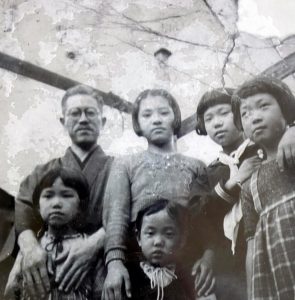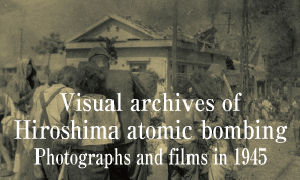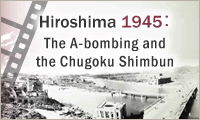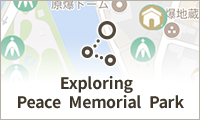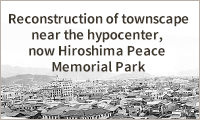Documenting Hiroshima of 1945: Late September, school building Ms. Goto was proud of left in terrible state
Sep. 24, 2024
by Fumiyasu Miyano and Minami Yamashita, Staff Writers
In late September 1945, Honkawa National School (present-day Honkawa Elementary School, in Hiroshima’s Naka Ward), the school closest to the hypocenter, was standing in ruins. The interior of the city’s first ferroconcrete public elementary school building, completed in 1928, had been burned out and the walls and window frames on the second and third floors, facing the hypocenter, were twisted, wave-like, by the blast from the atomic bombing.
Mutsuko Goto, a 90-year-old resident of Fujisawa City, Kanagawa Prefecture, felt great pride in the school building before the bombing as a sixth grader at the time. She would look at the Hiroshima Prefectural Industrial Promotion Hall (present-day A-bomb Dome) from her third-floor classroom every day and swim in the Honkawa River, next to the school, in the summer. However, once the Pacific theater of World War II had begun, she and the other students would also participate in safety drills that involved jumping into holes dug in the schoolyard and running away. She said, “My teacher was strict, constantly insisting that the American soldiers were brutal.”
At the time of the bombing, she was in the area of Tokaichi-machi (in present-day Miyoshi City), sent there with other students in group evacuations. On August 18, as other children were being picked up by their families, her fourth oldest sister, who had been in Tokyo, showed up. Ms. Goto was so joyful she jumped to greet her sister. “No one else came to pick me up,” she said. She and her sister went to the central area of Hiroshima in search of family and caught sight of the destroyed school. “I couldn’t speak. Without knowing what had happened to my family, all I could do was cry,” said Ms. Goto.
The two traveled to Nomi Island (in present-day Etajima City) and were able to reunite with their mother, Kiyomi, 45 at the time, who had fled to her family home on the island. Soon after, their mother developed purple spots over her entire body, and her face swelled up like a balloon. She died at the beginning of September. Ms. Goto’s father, Kiyomi, 47 at the time, a dentist who also served as a school physician, and her three older sisters all died in the bombing.
Around 400 students and 10 teachers and staff at Honkawa National School were killed in the bombing. In February 1946, the school resumed classes jointly with Hirose National School (present-day Hirose Elementary School, in Hiroshima’s Naka Ward). Ms. Goto remained on Nomi Island and was not able to return to the school.
(Originally published on September 24, 2024)
In late September 1945, Honkawa National School (present-day Honkawa Elementary School, in Hiroshima’s Naka Ward), the school closest to the hypocenter, was standing in ruins. The interior of the city’s first ferroconcrete public elementary school building, completed in 1928, had been burned out and the walls and window frames on the second and third floors, facing the hypocenter, were twisted, wave-like, by the blast from the atomic bombing.
Mutsuko Goto, a 90-year-old resident of Fujisawa City, Kanagawa Prefecture, felt great pride in the school building before the bombing as a sixth grader at the time. She would look at the Hiroshima Prefectural Industrial Promotion Hall (present-day A-bomb Dome) from her third-floor classroom every day and swim in the Honkawa River, next to the school, in the summer. However, once the Pacific theater of World War II had begun, she and the other students would also participate in safety drills that involved jumping into holes dug in the schoolyard and running away. She said, “My teacher was strict, constantly insisting that the American soldiers were brutal.”
At the time of the bombing, she was in the area of Tokaichi-machi (in present-day Miyoshi City), sent there with other students in group evacuations. On August 18, as other children were being picked up by their families, her fourth oldest sister, who had been in Tokyo, showed up. Ms. Goto was so joyful she jumped to greet her sister. “No one else came to pick me up,” she said. She and her sister went to the central area of Hiroshima in search of family and caught sight of the destroyed school. “I couldn’t speak. Without knowing what had happened to my family, all I could do was cry,” said Ms. Goto.
The two traveled to Nomi Island (in present-day Etajima City) and were able to reunite with their mother, Kiyomi, 45 at the time, who had fled to her family home on the island. Soon after, their mother developed purple spots over her entire body, and her face swelled up like a balloon. She died at the beginning of September. Ms. Goto’s father, Kiyomi, 47 at the time, a dentist who also served as a school physician, and her three older sisters all died in the bombing.
Around 400 students and 10 teachers and staff at Honkawa National School were killed in the bombing. In February 1946, the school resumed classes jointly with Hirose National School (present-day Hirose Elementary School, in Hiroshima’s Naka Ward). Ms. Goto remained on Nomi Island and was not able to return to the school.
(Originally published on September 24, 2024)

